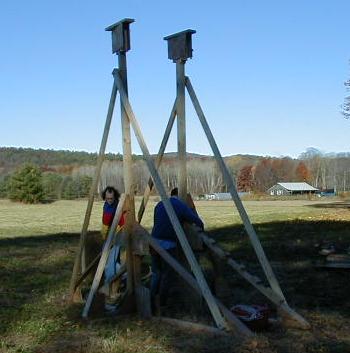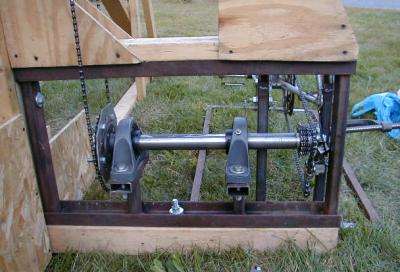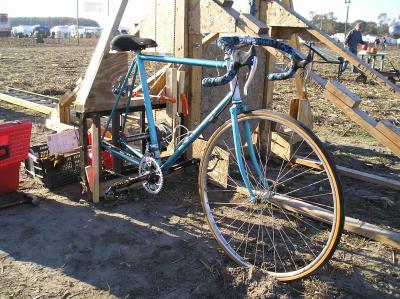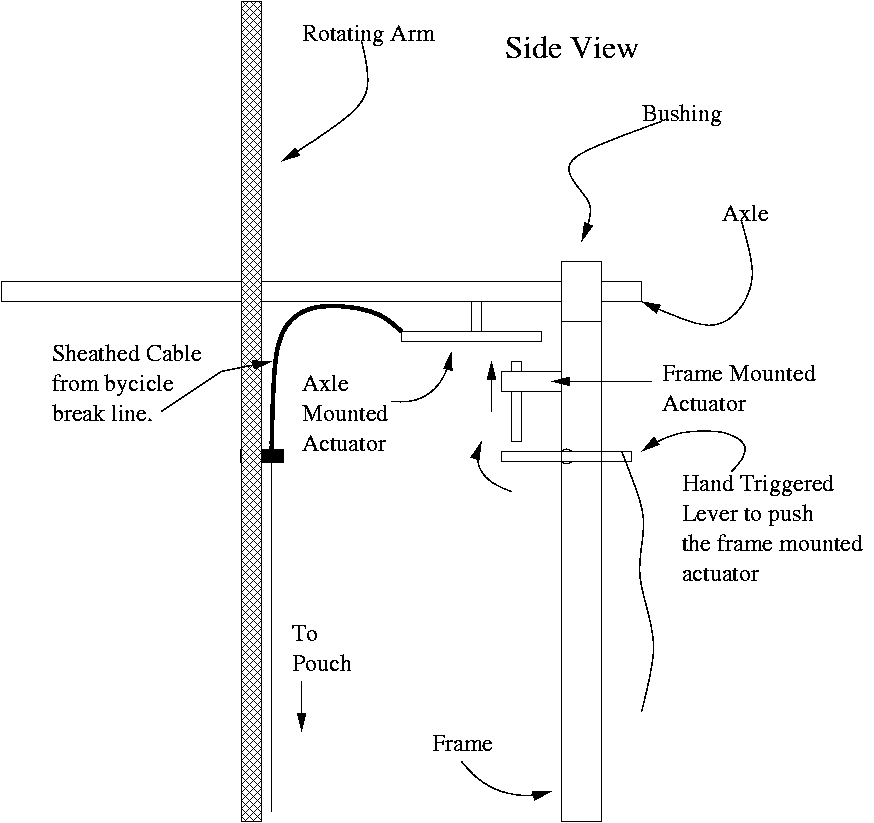|
|
Centripetal throwing machines don't fit the classic concept of "Catapult", but they sure are fun. Our machine, Pumpkin Putter, has been through several iterations over several years and we learned quite a bit about tuning these machines.
All the engineering advice on this page relates to light duty, direct human drive centripetal catapulting.
| Drive Train |
 To hold the drive train together, it is important to have a sturdy frame. This is our earliest frame,
and it was pretty stiff. We eventually moved to a system cables that were pinned into the ground in place
of the long beams going from the top of the frame toward the outer base.
To hold the drive train together, it is important to have a sturdy frame. This is our earliest frame,
and it was pretty stiff. We eventually moved to a system cables that were pinned into the ground in place
of the long beams going from the top of the frame toward the outer base.
 To capture the human input, this Jack-Shaft box would transfer the power from the bicycle (on the right)
closer toward the machine so it could travel up the frame via a very long bicycle chain.
To capture the human input, this Jack-Shaft box would transfer the power from the bicycle (on the right)
closer toward the machine so it could travel up the frame via a very long bicycle chain.
 Eventually, all we ended up with was a bicycle with the rear tire bracket bolted right onto the machine.
This greatly simplified the design which used to include various types of platforms that had to be
disassembled for transport. Having the bicycle bolt directly to the machine provides maximum
stability and removes a lot of wobble and compression while attempting to apply maximum force while pedaling.
Eventually, all we ended up with was a bicycle with the rear tire bracket bolted right onto the machine.
This greatly simplified the design which used to include various types of platforms that had to be
disassembled for transport. Having the bicycle bolt directly to the machine provides maximum
stability and removes a lot of wobble and compression while attempting to apply maximum force while pedaling.
 The chain then drives up the frame to an upper chain-ring. Just below and left of the chain ring you
can see a very large derailleur hooked up to a very large spring (out of an old oven door.)
The chain then drives up the frame to an upper chain-ring. Just below and left of the chain ring you
can see a very large derailleur hooked up to a very large spring (out of an old oven door.)
The chain rose 14 feet from the ground, and while everything was moving, the 10" derailleur arm would move up and down about 6 inches. The amount of wobble in the system this large derailleur accounted for is truly amazing.
| Triggering a Centripetal Machine |
A Centripetal trigger has at least three major pieces. Part1 is a frame-mounted actuator. The purpose of this actuator is to push into the path of an axle mounted actuator. The axle mounted actuator then causes a final triggering system on the throwing pouch to let go of the projectile.
The following diagram shows the first two parts.


| Pouch Release |
 Our first throwing pouch was a great idea that Kevin came up with.
The blue straps held in the projectile, and a cable cinched the pouch closed.
When the cable tension was release, the projectile would push open the
pouch and release the projectile.
Our first throwing pouch was a great idea that Kevin came up with.
The blue straps held in the projectile, and a cable cinched the pouch closed.
When the cable tension was release, the projectile would push open the
pouch and release the projectile.
This device was very simple, and worked well. Video inspection caused us to ponder that it may be preventing a quick release, making the timing of the release difficult to gage.
 This is our Super-Spring powered basketball pouch.
To provide the easiest egress for the pumpkin, we moved to this spring-powered over-lock pouch.
It took a long time to design and fabricate this thing.
This is our Super-Spring powered basketball pouch.
To provide the easiest egress for the pumpkin, we moved to this spring-powered over-lock pouch.
It took a long time to design and fabricate this thing.
A basket ball was cut in half to provide a stiff shell to hold the pumpkin. A spring from an old stove was attached to the two angled cables which go toward the top of the image from the sides of the pouch. On top of the pouch, is a bar-lock using a similar technique to vice-grips. In this picture, a bit of pink nylon line is tied to the bar-lock central hinge. Pulling this line cause the bar-lock to open, and allowed the spring to pull the pouch completely open with great rapidity.
 The final pouch.
The final pouch.
With what the other pouched had with complexity, this made up for in simplicity. The actuator would just tug lightly on the vice-grip release lever, and POP, it would let go of the ring that cinched in the pumpkin.
A cinch strap allowed for a wide variation in projectile size, and allowed for a super-tight fit against the pumpkin platform. The pumpkin would be put in loose, and the cinch strap would hold it in place.
